In the heart of the tropical rainforest in South America, a mysterious and charming amphibian lurks named the Smoky Jungle frog. Due to its unique vocalization, this frog always attracts the attention of wildlife researchers and photographers.
In this blog, we will delve into the world of Smoky Jungle frogs where we will discuss everything from its physical characteristics to its unique vocalization. Just keep reading.
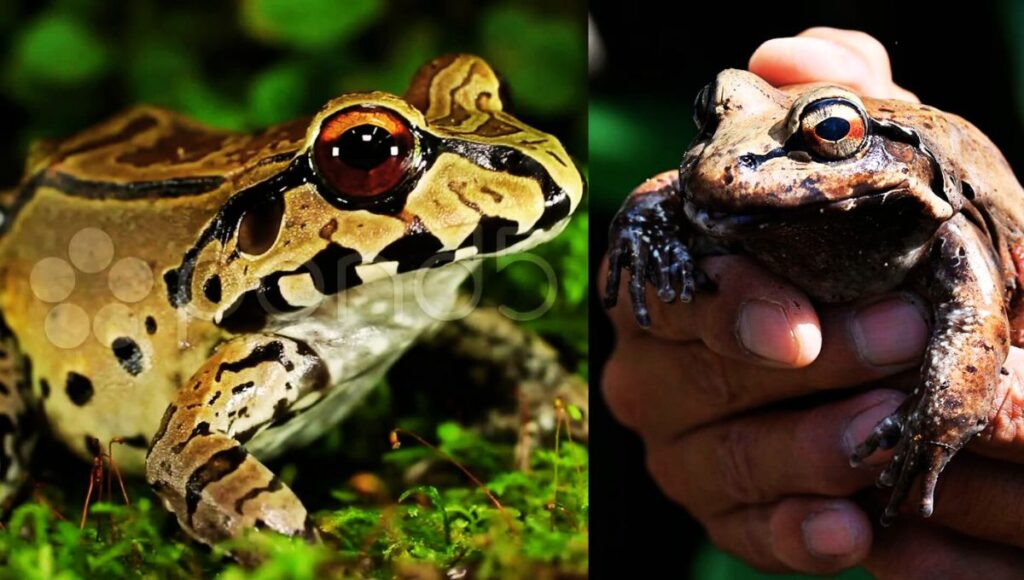
Table of Contents
Smoky Jungle Frog- In a Glimpse:
| Common Name: | Smoky Jungle Frog |
| Scientific Name: | Leptodactylus pentadactylus |
| Other Names: | Huwa (Brazil), Savage’s Thin-toed Frog and Central American Bullfrog |
| Group Name: | Army, Chorus, Colony |
| Adult Weight: | 250-400 g |
| Adult Length: | 17-18 cm |
| Colour: | Brown to Grey |
| Characteristics: | Nocturnal |
| Distribution: | Bolivia, Brazil, Coast Rica, Colombia, Peru and French Guiana |
| Habitats: | Tropical and sub-tropical rainforests. |
| Lives in: | Burrows, under logs, leaves or in muds. |
| Diets: | Omnivorous |
| Predators: | Large snakes, caimans and coatimundis. |
| Threats: | Deforestation, destruction of rainforests, habitat loss and pollution. |
| Life Span: | 15 years in the wild and 20 years in captivity. |
| Sexual Maturity: | 3 Years. |
| IUCN Status: | Least Concern |
| Distinctive Features: | High Pictch Scream |
| Defence Mechanism: | emits highly toxic Leptodactylin. |
Everything About Smoky Jungle Frog:
Scientific Classification:
| Domain: | Eukaryota |
| Kingdom: | Animalia |
| Phylum: | Chordata |
| Class: | Amphibia |
| Order: | Anura |
| Family: | Leptodactylidae |
| Genus: | Leptodactylus |
| Species: | Leptodactylus pentadactylus |
Physical Characteristics:

This is one of the largest frogs in the world. The frog displays sexual dimorphism as the male one is slightly larger than the female. The maximum snout-to-vent length for a male is about 18 cm whereas for a female it is nearly 17.5 cm. A robust body, large head, rounded snout and prominent tympanum make this species unique compared to other frog species.
The skin on the dorsum and venter is smooth. The fingers and toes are long with thin tips and without webbing. The breeding males have swollen forelimbs. A large pointed black spine on the inner surface of the thumb and two black spines on each side of the chest.
The colour of the body varies from brown to grey with a dark mark. This colouration helps the smoky jungle frog to display camouflage in the rainforest. They also have two bronze colour iris.
When threatened the frog species try to appear bigger by inflating their lungs and standing tall on four legs. They secret a toxic mucus-like chemical from their skin and also emit a high-pitched scream.
Distribution and Habitats:
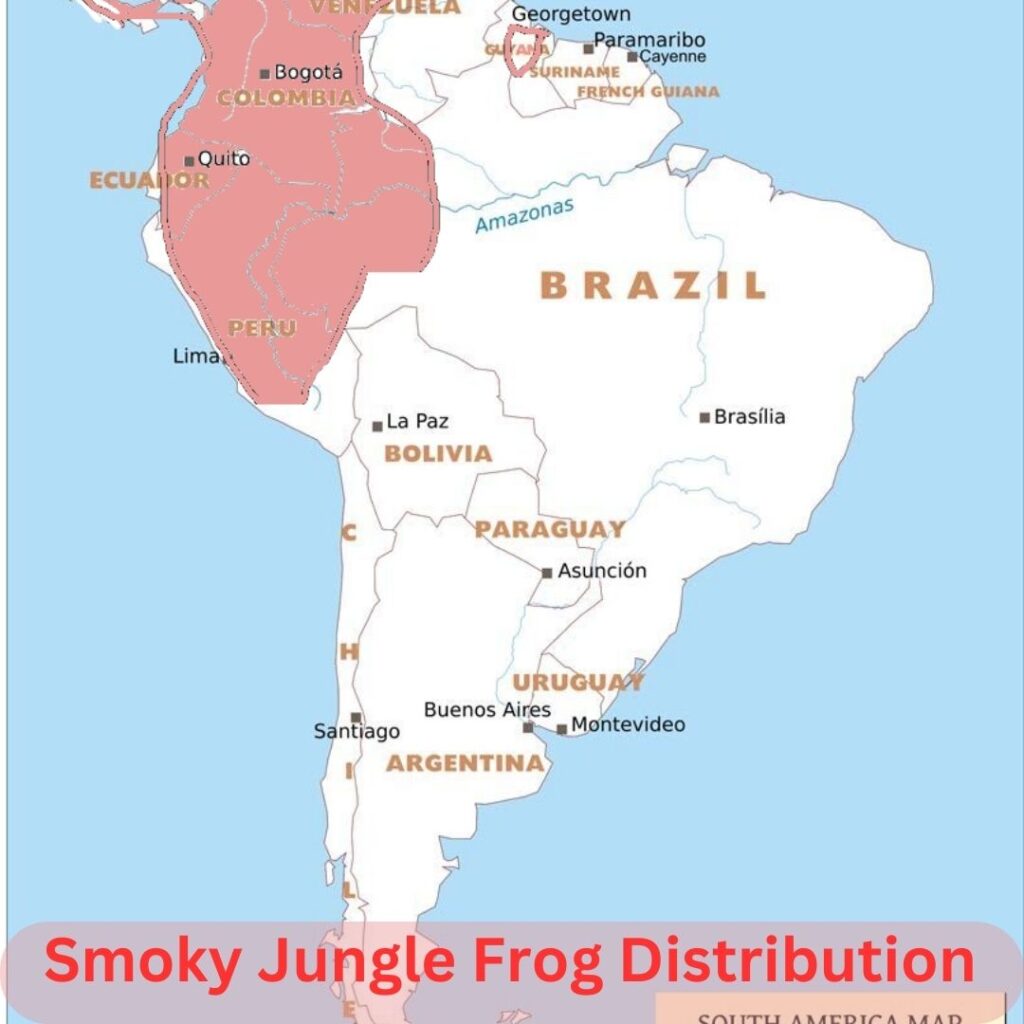
Smoky jungle frogs usually live below 1200 m (3900 ft) from Costa Rica to the Pacific lowlands of Ecuador. More precisely it is found in Bolivia, Brazil, Coast Rica, Colombia, Peru and French Guiana.
The frog species usually prefers tropical and sub-tropical moist broad-leaf forests, swamps, montane forests, rivers, freshwater marshes etc as their home.
Behaviour:
The frog species is usually nocturnal and thus it is mostly inactive during daytime. During the day they mostly live in burrows, hidden under logs, leaves or in mud.
Smoky jungle frogs are more active during the night. With the arrival of dusk, the species primarily leave their burrow to find food. They secret toxic chemicals from their skin as a defensive mechanism. They usually emit a unique high-pitched scream when grasped.
Diets:
The tadpoles are usually omnivorous. They usually feed on vegetation, other tadpoles and eggs (even their own eggs). The juveniles feed on small anthropods whereas larger adults feed on large anthropods, lizards, snakes, small mammals, birds and frogs. Cannibalism is seen in this frog species.
Vocalization:
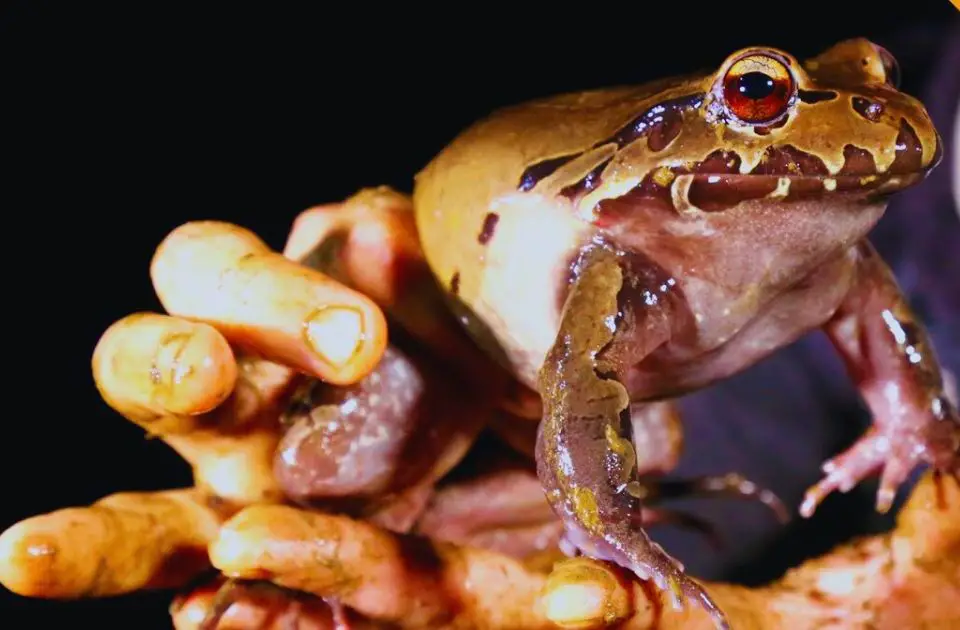
A distinctive feature of the smoky jungle frog is unique vocalization. During the breeding season, the male produces a unique and high-pitched vocal sound to attract female partners. This sound helps the researcher to find the species and study their behaviour and interaction with the ecosystem. This unique sound is also emitted when the frog is grasped or in threat.
Predators:
As the smoky jungle frog is the secondary consumer in the food chain, larger species like large snakes, caimans and coatimundis are the predators of the species.
Defence Mechanism:
One of the most fascinating facts about frogs is their defence mechanism against predators. They usually inflate their body and stand tall with four legs to look larger and secret a toxic chemical from the skin known as leptodactylin.
Leptodactylin is a mucus-like poisonous chemical that can cause rashes or a stinging sensation in humans. Interestingly, the frog can also vaporize the toxin into the air when needed and affect nearby people even without touching it. They also scream with a high pitch when they are disturbed or picked up.
Reproduction:
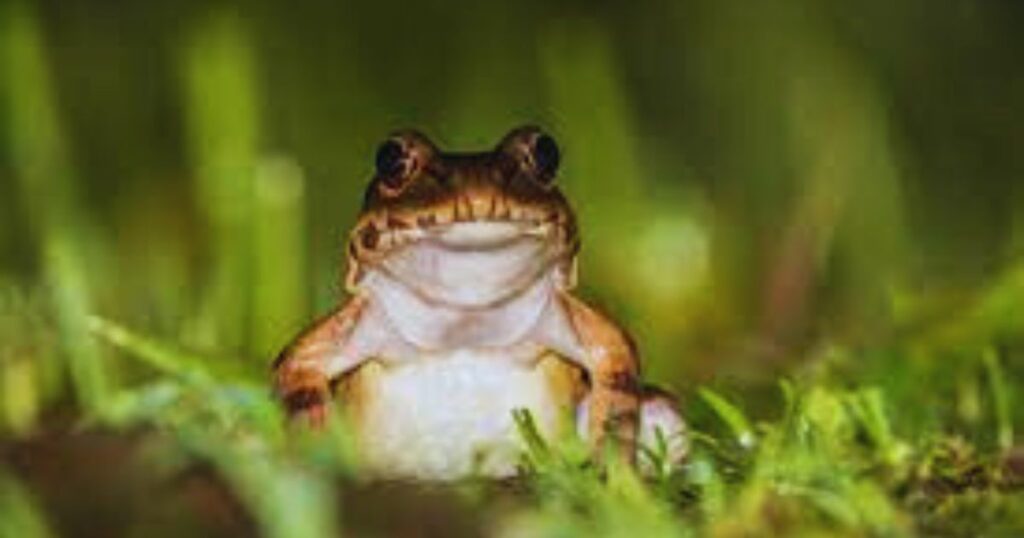
The breeding takes place in the rainy season when the humidity in the air rises. Males call solitarily from the side of the ponds or backwater. This sound is known as “whoorup” which is repeated every 5 or 10 seconds.
After a pair has finished amplexus, a female may deposit as many as 1000 eggs into a large foam next to the water bodies. The eggs hatch in 2 or 3 days and subsequent rainfalls help the nest site and the tadpoles to move into the pond or slow-moving stream.
The development of tadpoles is rapid and tadpoles can attain a maximum of 3.3-inch length. Metamorphosis occurs after 4 weeks after hatching and the tadpoles become juvenile frogs.
Threats faced by Smoky Jungle Frog:
Although the population of smoky jungle frogs is abundant in the wild, they face various threats in the ecosystem. Deforestation, destruction of rainforests, habitat loss and pollution are some of the major concerns. Also, illegal trade and too many studies on them are nowadays treated as threats to the species.
Disease:
Like other wild frog species, Smoky Jungle frogs are prone to be attacked by fungi and parasites. Chytrid fungus causes a deadly skin disease (chytridiomycosis) that is a threat to the species.

Life Span:
The smoky jungle frog can live up to 15 years in the wild but it can live up to 20 years in captivity.
Conservation Status:
The frog species is listed as “Least Concern” in the IUCN Red List of Threatened Species but it is not listed in CITES.
Are Smoky Jungle frogs good pets?
Smoky Jungle frogs can be good pets but they are not for beginners. If you are a frog enthusiast and have a lot of experience with other poisonous frogs, then you can handle these frogs. However, the frogs are easy to care for, low maintenance, and enjoyable to watch but there are some threats associated with the jungle frogs.
These frogs are highly toxic and secrete leptoxin chemicals from their skins which cause rashes and stinging sensations in humans. The frogs can vaporize the toxic substance into the air when it is threatened by people or feel the presence of humans around. Hence, if you are a beginner or hobbyist and have a child and an old person at your home, avoid this frog as a pet.
How do you buy a Smoky Jungle frog?
Avoid buying these jungle frogs from illegal pet markets. Because in the illegal pet markets, they often sell illegally captured frogs which are often attacked by fungi or parasites. Also, the practice of buying frogs from illegal pet markets encourages illegal trafficking and poaching.
Hence, buy Smoky Jungle frogs only from reputed pet breeders and pet shops where you can ensure the frog is born and bred in captivity. Ask for proof of origin, health certificates, and other information before buying. Also, check the laws of your country and state if the frog is illegal to be kept as a pet in your region.
However, you can also check out the frog from online sources. But read their policy, and reviews, and ensure trustworthiness before buying.
The price of the Jungle frogs will vary depending on their size, age, sex, health condition, region, and availability. But you can expect to spend at least $50 for one frog.
Requirements and Care:
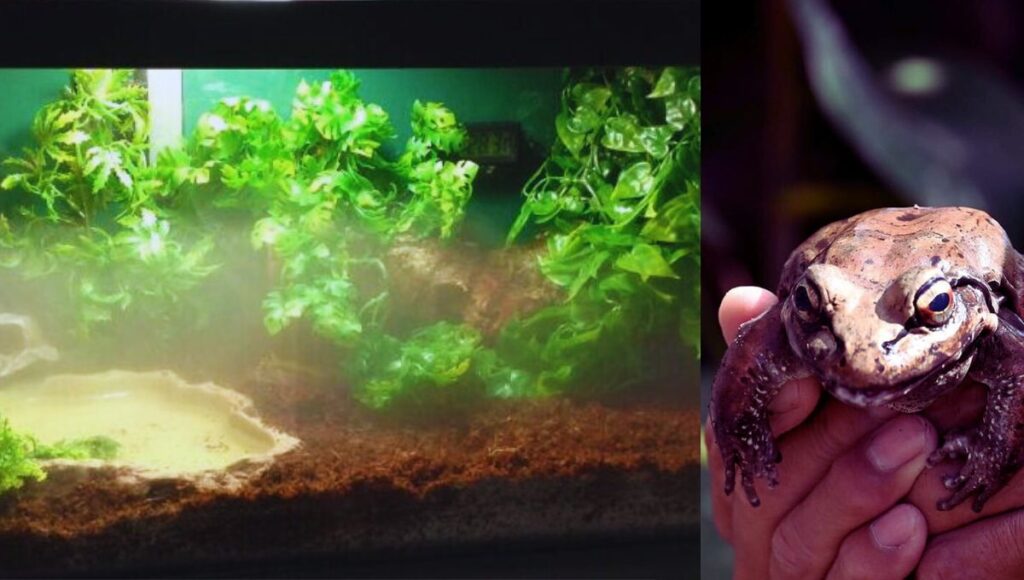
Enclosure:
A 10-gallon tank is required for one Smoky Jungle frog that has a secure lid and proper ventilation system. However, the bigger the tank, the better for the frog. As the Jungle frog is territorial by nature, the enclosure must have at least 80% land area and 20% or less aquatic area. The land and aquatic areas can be divided by plexiglass or cork flats. You’ll also need some live or artificial plants inside the tank, that provide space for the frog to hide in the daytime.
Can You keep two Smoky Jungle frogs in the same container? Or can you keep other frogs or amphibians with the Jungle frog?
Smoky Jungle frogs are solitary by nature and often show cannibalism. Hence, it is advised not to keep any other frog in the same container. The frogs fight with their own species and kill and consume them.
The Jungle frogs can also fight with other frog species in the container and kill them. Apart from that, Smoky Jungle tree frogs emit very toxic substances from their skin, which can harm or kill other frog species or amphibians. Hence, it is advised to keep only one frog in a container.
Substrate:
You can use coconut fibre, sterile potting soil, and sphagnum moss as a substrate (similar to Pacman frogs) for these frogs as these substrates can hold moisture. The substrate must be 2-3 inches deep as Smoky Jungle frogs love to burrow.
Temperature and Humidity:
The Jungle frogs require a hot but moist environment to thrive. To match their native environment you need to keep the temperature of the tank between 75 and 95 degrees Fahrenheit. Use a thermometer to monitor the temperature and if the tank is cold, use a heat mat or heat lamp to warm it. Be careful and avoid overheating or it’ll harm these frogs.
The frogs also need high humidity levels (80-90%) to thrive. Use a hygrometer to check the humidity levels, and also use a fogger to control the humidity. You can also sprinkle water several times a day to maintain the humidity level high.
Light:
Like any other frogs, Smoky Jungle frogs require a 12-hour day and night circle to regulate their activities. You can use a low-wattage fluorescent bulb or UVB/UVA to provide them with sufficient light and vitamin D.
Food and Water:
Adult frogs are carnivorous whereas the tadpoles are omnivorous. You need to feed the tadpoles daily but feed the adults every other day to prevent obesity. The amount of food required depends on their age, size, sex, health condition, and appetite level.
You can feed tadpoles small arthropods such as Millipede, spiders, beetles, ants, and other small insects with some algae. However, you have to feed an adult frog with crickets, small lizards, snakes, pinky mice, and insects. Twice a week dust their food with calcium and vitamin supplements to provide them proper nutrition. Also, provide them with sufficient dechlorinated water to drink.
Cleaning:
You have to clean the water dish, dead insects, and wasted food regularly from the enclosure to avoid bacterial growth. Once a month deep clean the tank with mild disinfectant. Also, change the substrate every 3-4 months if it doesn’t smell bad.
Handling:
Sadly, Smoky Jungle frogs don’t like to be handled by humans. If you want to communicate with them, feed the frogs with soft-tipped tongs. Unnecessary touches give the frog stress and the frogs secrete the toxic substance from the skin and vaporize that in the air. Hence, wear gloves on your hands and glass on your eyes before handling them, and wash your hands carefully afterwards.
Hence, it is clear, that you need to be very careful while keeping Smoky Jungle frogs as pets. If you are a beginner or want to have a frog as a pet just to show off, it is advised to avoid this toxic frog species.
Frequently Asked Questions (FAQ):
Is A smoky Jungle frog poisonous?
Yes, the frog species is very poisonous. It secretes a chemical (leptoxin) from the skin and it causes rashes and stinging sensations in humans. The frog can also vaporize its toxic chemical into the air when threatens and affects the people around.
What is the habitat of the Smoky Jungle frog?
The Smoky Jungle frog is generally found in Costa Rica, Bolivia, Colombia, Brazil, Peru, Ecuador and French Guiana. The frog species usually prefers tropical and sub-tropical moist broad-leaf forests, swamps, montane forests, rivers, freshwater marshes etc as their home.
What do smoky jungle frogs eat?
The adult frog feeds on feed on large arthropods, lizards, snakes, small mammals, birds and frogs. Cannibalism is seen in this frog species. But the tadpoles are omnivorous. They often consume vegetation and insects as a diet.
What are some interesting facts about smoky jungle frogs?
They are nocturnal. They often spend their daytime in burrows and mud.
The males are larger than the females and reach up to 18 cm in length.
The frog species is poisonous. It secretes toxic chemicals which can cause rashes and stinging sensations in humans.
When the frog is disturbed or picked up, it emits a very high-pitched scream and it helps the researcher to identify a smoky jungle frog.
Despite being poisonous, some tribes in the Amazon basin consume this frog.
Smoky jungle frogs can live up to 15 years in the wild and 20 years in captivity.
What is the most poisonous frog touch?
Golden Poison Frog is not only one of the most poisonous amphibians but also one of the most poisonous animals on the planet. The frog secretes deadly alkaloid batrachotoxins from its skin and it can lead to cardiac failure.
Smoky Jungle Frog is a heritage of the rainforest that catches the eyes of wildlife enthusiasts and photographers to other animals of the forest. If we can ensure their presence in their natural habitat then we can gift a mesmerizing creature to our future generation.
References: Smoky Jungle Frog on Wikipedia